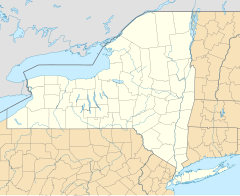Barcelona Light

Historical View of Barcelona Lighthouse from the southwest
|
|
| Location | Barcelona Harbor on Lake Erie in Westfield (town), New York |
|---|---|
| Coordinates | 42°20′27″N 79°35′42″W / 42.34083°N 79.59500°WCoordinates: 42°20′27″N 79°35′42″W / 42.34083°N 79.59500°W |
| Year first constructed | 1829 |
| Year first lit | 1829 |
| Deactivated | 1859 |
| Foundation | Natural emplaced |
| Construction | Fieldstone |
| Tower shape | Conical |
| Markings / pattern | Natural |
| Height | 40 feet (12 m) |
| Original lens | 11 lamps with 14-inch (360 mm) reflectors |
| ARLHS number | USA-038 |
| USCG number | |
|
Barcelona Lighthouse
|
|
| Area | 0 acres (0 ha) |
| NRHP Reference # | 72000825 |
| Added to NRHP | April 13, 1972 |
Barcelona Light, also known as Portland Harbor Light, is a lighthouse overlooking Barcelona Harbor on Lake Erie in the Town of Westfield, New York.
Westfield was once part of the Town of Portland and the natural harbor there was known as Portland Harbor. When the Town of Westfield was established formally in 1823, the harbor area became known as Barcelona.
The lighthouse was established in 1829 through the efforts of Thomas B. Campbell. The conical tower and attached keeper's cottage were constructed of fieldstone, with a natural, emplaced foundation. The light was emitted by eleven lamps with 14-inch (360 mm) reflectors. It was the first lighthouse in the world to be powered by natural gas, which Campbell transported from a "burning spring" about a mile distant by means of wooden pipes. Thirty years later, in 1859, the lighthouse was deactivated, but it still stands lit today after over 100 years in private ownership, it is now owned by the New York State Office of Parks, Recreation, and Historic Preservation.
The lighthouse was added to the National Register of Historic Places in 1972.
Congress appropriated $5,000 on May 23, 1828, "for building a lighthouse at a proper site, at or near Portland, on Lake Erie, in the State of New York." The site was purchased for $50 and contract was made to erect a lighthouse and dwelling which cost $3,456.78. The first keeper appointed May 27, 1829, was Joshua Lane, a "deaf, superannuated clergyman, having numerous female dependents" whose salary was $350 per annum. The first light apparatus was described in the contract as 11 patent lamps with 11 14 inch reflectors and 2 spare lamps. There were double tin oil butts for 500 US gallons (1,900 l; 420 imp gal) of oil. No mention was made at that time of equipment for burning natural gas.
On January 1, 1831, a contract was made to provide the light with natural gas "at all times and seasons" and to keep the apparatus and fixtures in repair at an annual cost of $213. This was described at the time as follows: "The Lighthouse at Portland Harbor in the County of Chautauqua and State of New York, is now illuminated, in the most splendid style, by natural carburetted hydrogen gas. Ever since the first settlement of the country about Portland, it has been known that an inflammable gas constantly issued from the fissures of a rock, which forms the bed of a little brook that empties into Lake Erie, near the harbor, in such quantity as to be easily set on fire by applying a flame to it. This fountain of gas was known to the early settlers of the country by the name of the 'burning spring.’ No valuable use, however, was made of this gas until Mr. W. A. Hart, an ingenious gunsmith of the village of Fredonia, and some other young mechanics, five or six years ago, collected a quantity of similar gas from the rocky bed of Canadaway creek in a reservoir, and conveyed it from thence to all the principal stores, taverns, and shops in the said village, where it is still used instead of lamps."
...
Wikipedia

